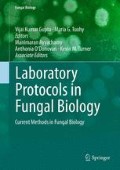Abstract
Gene silencing in fungi produces a range of phenotypes based on the different amounts of target mRNA that are degraded by the RNAi machinery in each transformed strain. Detection of this range of variation when analyzing groups of transformants requires a fast and sensitive method. Quantitative or real-time PCR of reverse-transcribed target mRNA is particularly well suited for this analysis.
Access this chapter
Tax calculation will be finalised at checkout
Purchases are for personal use only
Notes
- 1.
Check www.gene-quantification.info for examples and download links.
- 2.
For example Invitrogen Trizol Reagent. Cat. Number: 15596-026. http://products.invitrogen.com/ivgn/product/15596026.
- 3.
Optional: the addition of formaldehyde denatures the high secondary structure of the RNA molecule for a clear visualization.
- 4.
Roche cat. Numbers: 05081955001/05091284001/05081963001. http://www.roche-applied-science.com/proddata/gpip/3_6_8_39_1_3.html.
- 5.
Invitrogen cat. Numbers: 18080-093/18080-044/18080-085. http://www.invitrogen.com/site/us/en/home/Products-and-Services/Applications/Nucleic-Acid-Amplification -and-Expression-Profiling/Reverse-Transcription-and-cDNA-Synthesis/RT___cDNA_Synthesis-Misc/SuperScript.html.
- 6.
For Roche Lightcycler 480 there is an import tool available in http://www.hartfaalcentrum.nl/index.php?main=files&sub=0
References
Fire A, Xu S, Montgomery MK, Kostas SA, Driver SE, Mello CC (1998) Potent and specific genetic interference by double-stranded RNA in Caenorhabditis elegans. Nature 391:806–811
Salame TM, Ziv C, Hadar Y, Yarden O (2011) RNAi as a potential tool for biotechnological applications in fungi. Appl Microbiol Biotechnol 89:501–512
Liu H, Cottrell T, Pierini L, Goldman W, Doering T (2002) RNA interference in the pathogenic fungus Cryptococcus neoformans. Genetics 160:463–470
Ngô H, Tschudi C, Gull K, Ullu E (1998) Double-stranded RNA induces mRNA degradation in Trypanosoma brucei. Proc Natl Acad Sci U S A 95:14687–14692
Janus D, Hoff B, Hofmann E, Kück U (2007) An efficient fungal RNA-silencing system using the DsRed reporter gene. Appl Environ Microbiol 73:962–970
Nolan T, Hands RE, Bustin SA (2006) Quantification of mRNA using real-time RT-PCR. Nat Protoc 1:1559–1582
Bustin SA (2002) Quantification of mRNA using real-time reverse transcription PCR (RT-PCR): trends and problems. J Mol Endocrinol 29:23–39
Thellin O, ElMoualij B, Heinen E, Zorzi W (2009) A decade of improvements in quantification of gene expression and internal standard selection. Biotechnol Adv 27:323–333
Vandesompele J, Kubista M, Pfaffl M (2009) Reference gene validation software for improved normalization. In: Logan J, Edwards K, Saunders N (eds) Real-time PCR: current technology and applications. Caister Academic, Norwich, pp 47–64
Vandesompele J, De Preter K, Pattyn F, Poppe B, Van Roy N, De Paepe A et al (2002) Accurate normalization of real-time quantitative RT-PCR data by geometric averaging of multiple internal control genes. Genome Biol 3(7):research0034.1–research0034.11
Elbashir SM, Harborth J, Lendeckel W, Yalcin A, Weber K, Tuschl T (2001) Duplexes of 21-nucleotide RNAs mediate RNA interference in cultured mammalian cells. Nature 411:494–498
Van Maerken T, Mestdagh P, De Clercq S, Pattyn F, Yigit N, De Paepe A et al (2009) Using real-time qPCR to evaluate RNAi-mediated gene silencing. In: BioTechniques protocol guide 2009. p. 47. Biotechniques, NY, USA. DOI: 10.2144/000113006
Schmittgen T, Livak K (2008) Analyzing real-time PCR data by the comparative CT method. Nat Protoc 3:1101–1108
Livak K, Schmittgen T (2001) Analysis of relative gene expression data using real-time quantitative PCR and the 2ΔΔCT method. Methods 25:402–408
Pfaffl MW (2001) A new mathematical model for relative quantification in real-time RT-PCR. Nucleic Acids Res 29:e45
Ramakers C, Ruijter J, Deprez R, Moorman A (2003) Assumption-free analysis of quantitative real-time polymerase chain reaction (PCR) data. Neurosci Lett 339:62–66
Ruijter J, Ramakers C, Hoogaars W, Karlen Y, Bakker O, van den Hoff M et al (2009) Amplification efficiency: linking baseline and bias in the analysis of quantitative PCR data. Nucleic Acids Res 37(6):e45
Nordgård O, Kvaløy JT, Farmen RK, Heikkilä R (2006) Error propagation in relative real-time reverse transcription polymerase chain reaction quantification models: the balance between accuracy and precision. Anal Biochem 356:182–193
Huggett J, Dheda K, Bustin S, ZumLa A (2005) Real-time RT-PCR normalisation; strategies and considerations. Genes Immun 6:279–284
Fleige S, Pfaffl MW (2006) RNA integrity and the effect on the real-time qRT-PCR performance. Mol Aspects Med 27:126–139
Antonov J, Goldstein DR, Oberli A, Baltzer A, Pirotta M, Fleischmann AR et al (2005) Reliable gene expression measurements from degraded RNA by quantitative real-time PCR depend on short amplicons and a proper normalization. Lab Invest 85:1040–1050
Nolan T, Bustin SA (2004) Pitfalls of Quantitative Real-Time Reverse-Transcription Polymerase Chain Reaction. J Biomol Tech 15:155
Stahlberg A (2004) Properties of the Reverse Transcription Reaction in mRNA Quantification. Clin Chem 50:509–515
Bustin S, Benes V, Garson J, Hellemans J, Huggett J, Kubista M et al (2009) The MIQE guidelines: minimum information for publication of quantitative real-time PCR experiments. Clin Chem 55:611
Bustin S, Beaulieu J, Huggett J, Jaggi R, Kibenge F, Olsvik P et al (2010) MIQE precis: Practical implementation of minimum standard guidelines for fluorescence-based quantitative real-time PCR experiments. BMC Mol Biol 11:74
Ramos B, Alves-Santos FM, García-Sánchez MA, Martín-Rodrigues N, Eslava AP, Díaz-Mínguez JM (2007) The gene coding for a new transcription factor (ftf1) of Fusarium oxysporum is only expressed during infection of common bean. Fungal Genet Biol 44:864–876
de Vega-Bartol JJ, Martín-Domínguez R, Ramos B, García-Sánchez MA, Díaz-Mínguez JM (2011) New virulence groups in Fusarium oxysporum f. sp. phaseoli: the expression of the gene coding for the transcription factor ftf1 correlates with virulence. Phytopathology 101:470–479
Alves-Santos F, Ramos B, García-Sánchez MA, Eslava AP, Díaz-Mínguez JMA (2002) DNA-based procedure for in-planta detection of Fusarium oxysporum f. sp. phaseoli. Phytopathology 92(3):237–244
Author information
Authors and Affiliations
Corresponding author
Editor information
Editors and Affiliations
Rights and permissions
Copyright information
© 2013 Springer Science+Business Media, LLC
About this chapter
Cite this chapter
de Vega-Bartol, J.J., Tello, V., Niño, J., Casado, V., Díaz-Mínguez, J.M. (2013). Quantitative PCR Analysis of Double-Stranded RNA-Mediated Gene Silencing in Fungi. In: Gupta, V., Tuohy, M., Ayyachamy, M., Turner, K., O’Donovan, A. (eds) Laboratory Protocols in Fungal Biology. Fungal Biology. Springer, New York, NY. https://doi.org/10.1007/978-1-4614-2356-0_22
Download citation
DOI: https://doi.org/10.1007/978-1-4614-2356-0_22
Published:
Publisher Name: Springer, New York, NY
Print ISBN: 978-1-4614-2355-3
Online ISBN: 978-1-4614-2356-0
eBook Packages: Biomedical and Life SciencesBiomedical and Life Sciences (R0)

